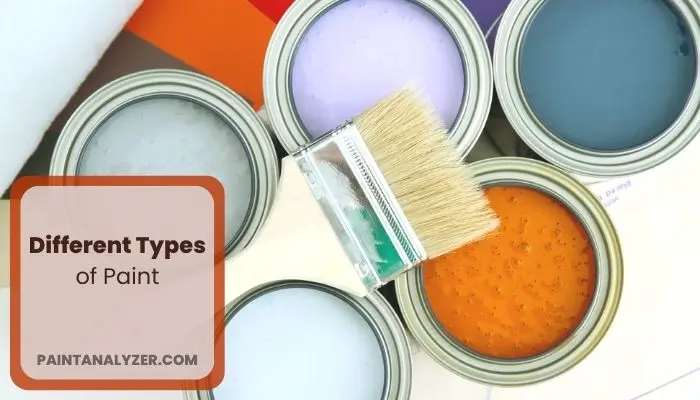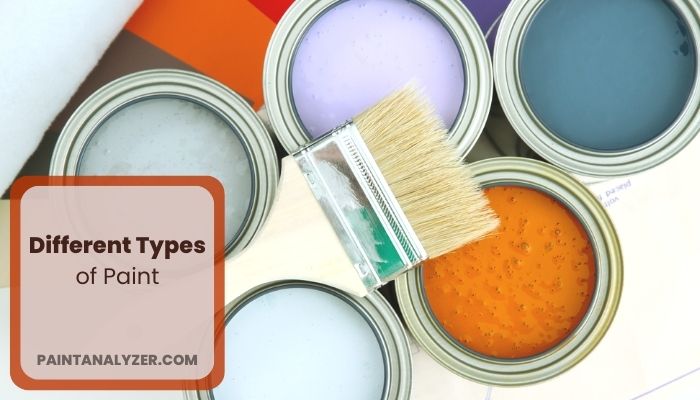Paint is a material that is applied as a liquid or paste to a surface and then dries to leave a thin film of solid coating. The main purpose of paint is to protect the surface it covers from damage, such as corrosion, UV light, abrasion, or chemicals. It can also be used for decorative purposes, to change the appearance of the covered surface.
There are many different types of paint available on the market, each with its own specific properties and uses. It can be made from a variety of materials, including acrylics, oils, alkyds, latexes, and epoxies.
Each type of paint has specific characteristics that make it more or less suitable for different applications. Here we’ll discuss about different types of paint and more about it. So read on to learn more!

Paint Types for Various Surfaces
Paint is one of the most versatile tools in a home improvement arsenal, but choosing the right type of paint for the job can be daunting. Here’s a quick guide to some of the most popular types of paint and their best uses: Latex paint is water-based and ideal for general-purpose painting projects like walls and ceilings.
It’s easy to clean up with just soap and water, making it a good choice for families with young children or pets. Oil-based paint is more durable than latex and better suited for high-traffic areas like trim, doors, and cabinets. It can be tricky to work with, so make sure you have plenty of ventilation when using it.
Chalkboard paint turns any flat surface into an interactive canvas! Perfect for kids’ rooms or play areas, all you need is a piece of chalk to get started. Just make sure to prime the area first with a layer of blackboard primer before painting on top.
What are the different Types of Interior Paint?
When it comes to painting the interior of your home, there are a variety of different paint types to choose from. Whether you’re looking for a paint that will give your walls a matte finish or one that will make them shine, there’s a paint type out there that’s perfect for you. Here are some of the most popular types of interior paint, along with a brief explanation of each:
Matte Paint
Popular matte paint is used to cover wall flaws and give surfaces an even, smooth appearance. Additionally, because it is simple to touch up, this kind of paint is a fantastic option for high-traffic areas like kitchens and bathrooms.
Eggshell Paint
For living rooms, bedrooms, and other areas where you want a little of sparkle without going crazy, eggshell paint is a popular option. This kind of paint has a subtle shine, which can give your walls depth and perspective. It is a wonderful option for high-traffic areas because it is very simple to clean.
Satin Paint
This paint type is perfect for those who want a bit of sheen on their walls without going overboard. Satin paint has a slight gloss to it, which gives walls a subtle sheen that’s perfect for rooms that receive a lot of natural light.
High-Gloss Paint
If you’re looking for a paint that will make your walls really shine, high-gloss paint is the way to go. This type of paint is also great for surfaces that are prone to dirt and stains, as it’s very easy to wipe clean. The only downside to high-gloss paint is that it can be a bit tricky to apply, so it’s best to leave this one to the professionals.
Semi-Gloss Paint
This type of paint is perfect for areas that see a lot of traffic or need to be cleaned often, such as kitchens and bathrooms. Semi-gloss paint has a bit of shine to it, which makes it easier to wipe clean if necessary.
Which of the Four Paint Types are they?
Whether you’re a beginner or a pro, understanding the different types of paint is essential to achieving the best results on your project. Not all paints are created equal—some are better suited for certain surfaces and techniques than others. Here’s a breakdown of the four most common types of paint so you can choose the right one for your next painting project:
1. Acrylic Paint Acrylic paint
This is a synthetic water-based paint that was first developed in the 1950s. It’s known for its versatility, as it can be used on a variety of surfaces, including canvas, wood, metal, and glass.
Acrylic paint dries quickly and has excellent coverage, making it a popular choice for both amateur and professional painters alike. One downside of acrylic paint is that it can be tricky to work with because it dries so quickly—if you make a mistake, you have to act fast to correct it before the paint sets.
2. Oil Paint
Since the 15th century, oil paint has been used and is remains one of the mediums of choice for artists today. It is renowned for its vibrant hues and silky texture, which may produce a lovely “glowing” effect in paintings.
It gives you more time to work with it and make adjustments if necessary because it takes longer to dry than other forms of paint (often about 24 hours).
However, this also means that oil paintings can take weeks or even months to fully cure, during which time they must be protected from dust and dirt lest they become ruined.
3. Primers
This type of paint is used to cover the surface with an opaque coat to allow the subsequent paint layers to adhere better and achieve better coverage.
That means it is not paint that you would use on your walls to achieve a certain color. Prepare the surface for the paint that will give your walls the desired color.
4. Paint Finishes
There are six basic types of paint finishes, each serving a different purpose: Flat, Matte, Eggshell, Semi-Gloss, High-Gloss, and satin. About these paints, we discuss above in detail:
What are the Three Paint Grades?
There are three primary grades of paint: primer, paint, and sealant. Each one has a different purpose and should be used accordingly. Primer is the first coat of paint that is applied to a surface.
It helps to protect the surface from damage, fill in any cracks or holes, and create a smooth base for the paint to adhere to. Paint is the second coat of paint that is applied over the primer. It is the color layer that will be visible once the project is complete.
Sealant is the third and final coat of paint. It helps to protect the project from weathering and fading.
Various paints for beginning painters – Fatema’s Art Show
– How Can Different Types of Paint be Utilized in Free House Paint Software and Color Visualizers?
When using a free house paint software and color visualizers, it’s essential to understand how different types of paint can be utilized. From flat finish to glossy sheen, the software allows users to experiment with various paint options and visualize the end result before making a decision.
How to Classify Paints for Interior and Exterior Use?
When it comes to mixing interior and exterior paint, it’s essential to consider the different properties needed for each environment. For interior use, opt for paints that are easy to clean and offer a smooth finish. For exterior use, choose paints that are durable and resistant to harsh weather conditions.
How are Anti-Slip Paints Classified and Used in Comparison to Other Types of Paints?
When it comes to safety and traction, types of anti-slip paints are an essential consideration. These specialized paints are classified based on their application surface and level of slip resistance. Unlike regular paints, anti-slip paints are designed to prevent accidents and provide a textured surface for better grip.
Conclusion
In conclusion, after reading this article, you should better understand the different types of interior paint and which of the four paint types are best suited for your project.
You should also be familiar with the three paint grades and how to determine the right paint for your project. Still, if you have any questions, please feel free to contact us, and we would be happy to answer any of your questions.

